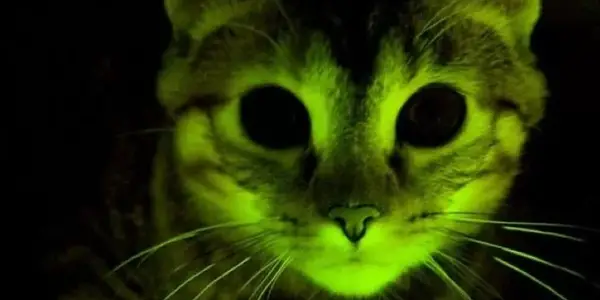Fantasy Science Pt. 21: Genetically Modified Animals In THE HUNGER GAMES & Real Life

Radha has a PhD in theoretical quantum physics. Apart from…
Genetic engineering. Mutations. Genetically modified animals. Have you heard terms like these flying around the science fiction sections of the film/TV world? Have you ever wondered just how accurately these films portray real science? Well, my friends, today is your lucky day: this column, Fantasy Science & Coffee, aims to bridge the gap between science and science fiction in films and popular culture. My hope is to explain things in a fun way – like we’re chatting over coffee.
You may be thinking: who is this person, why does she think she can explain science, and why the heck would I want to have coffee with her? Well, I’m Radha, a researcher in India, who recently submitted a PhD thesis in theoretical quantum physics. I quite like hot beverages. I’ll also pay.

We’ve previously discussed how gene editing can be achieved through CRISPR technology. In this twenty first part of the series published on the second and fourth Tuesdays of every month, we will focus on genetically modified animals in the context of The Hunger Games.
‘Muttations’ in The Hunger Games
Genetically modified animals are heavily present in the universe of The Hunger Games, and are called muttations, or ‘mutts’ for short. In fact, the iconic mockingjay — which became heroine Katniss Everdeen’s symbol as part of the Second Rebellion in the dystopian future depicted in the books and films — was the accidental spawn of muttations.
The Capital had genetically modified birds to create the jabberjay, a male bird with the ability to memorize and repeat back full human conversations. When people found out that the Capitol had created these winged spies, they fed them lies. The Jabberjays were soon released into the wild with the hope that they’d die out, but they ended up mating with mockingbirds to create the mockingjay. Mockingjays don’t have the ability to repeat back conversations, but they can imitate songs note for note, if they enjoy the voice of the singing person.
When Katniss and Rue, both tributes in the 74th Hunger Games, become allies, they use the mockingjays in the Arena to signal one another, with an iconic four note whistle.
The Arena is where the Hunger Games take place, and is stuffed with obstacles. One such obstacle is the presence of mutts called tracker jackers, which are genetically altered wasps that attack someone who has disturbed their nest. Attacks from regular wasps can be evaded by running away, but tracker jackers follow their targets irrespective of the distance. Their stings induce hallucinations, and cause pus-filled growths.
While the use of mutts makes for interesting storytelling, they aren’t solely the stuff of fiction. No, we cannot at this time create birds that can be sent to, say, an ex’s house for espionage, but scientists are turning to genetically modified animals for specific purposes. Let’s take a look at some of them!
Genetically Modifying Animals to Eradicate Disease
On Nantucket, a small island off the coast of Massachusetts, Lyme disease runs rampant, transmitted through ticks that bite a host, very commonly an infected mouse. Keven Esvelt, Director of the Sculpting Evolution group at the MIT Media Lab, is looking to curb Lyme disease on this island by identifying what causes natural immunity in certain mice, and using those elements to create a genetically engineered strain of mice that is immune to it.
In Africa, malaria, a disease spread through mosquitos, is the biggest killer of children under the age of five. Scientists, Austin Burt and Andrea Crisanti, are looking to eliminate a certain type of malaria-carrying mosquito by the rapid spread of a sterilizing mutation, through a method they call “gene drive”. From their 2018 ACS Chemical Biology paper:
Drive is a process of accelerated inheritance from one generation to the next that allows some genes to spread rapidly through populations even if they do not contribute to—or indeed even if they detract from—organismal survival and reproduction.
These are just two examples of what’s currently being researched when it comes to disease eradication through the large-scale spread of inheritable characteristics. Understandably, there are a number of concerns about potential ecological repercussions when something of this nature is released into the wild. Changing or eliminating one species could disrupt an entire ecosystem! Kevin Esvelt takes these concerns seriously, and says:
I worry every day that I might be missing something profound about the consequences of what we’re developing.
Genetic Enhancements
The most similar types of genetically modified animals to the muttations of The Hunger Games are those targeting enhancements in species. In 2015, scientists in China reportedly created super muscular beagles for hunting and police work, claiming the canines to be the world’s first gene-edited dogs.

Glow-in-the-dark animals have been created through genetic engineering for both ‘fun’ and research purposes, like studying infectious diseases and neurological disorders. They are inserted with a gene that produces the fluorescent protein called GFP, which is naturally produced in jellyfish. This fluorescence acts as a marker for geneticists to study other gene modifications.
For instance, glowing cats have been created to study the affect of a gene that provides resistance to the feline form of AIDS. Inserting both genes together quite literally sheds light on how this gene is passed down, and could provide useful insight for combating human AIDS.
Bringing Back Extinct Species
This one isn’t quite as Jurassic Park-esque as you may think. You may have heard about plans for a woolly mammoth comeback. The truth is that scientists are not looking at bringing back the woolly mammoth completely, they are instead inserting mammoth genes into its present-day cousin, the Asian elephant. This is the primary mission of the Woolly Mammoth Revival project of Revive & Restore. The project wasn’t established as a playground for geneticists. From their mission statement:
The ultimate goal of Woolly Mammoth revival is to bring back this extinct species so that healthy herds may one-day re-populate vast tracts of tundra and boreal forest in Eurasia and North America. The intent is not to make perfect copies of extinct Woolly Mammoths, but to focus on the mammoth adaptations needed for Asian elephants to thrive in the cold climate of the arctic. The milestones along the way range from developing elephant tissue cultures to genome editing and most importantly, developing insights that help with Asian elephant conservation.
There is, therefore, merit to looking at those who came before us. Though, once again, there are questions of how this would affect ecosystems, and how much is “too far” for us to go.
While our current knowledge of genetics doesn’t allow us to genetically modify animals to act as spies, muttations aren’t really beyond the realm of possibility given the strides we’ve made already.
If you could create a genetically modified animal with a specific purpose a la The Hunger Games, what would you create?
More to Explore
Articles
Wired: Science moves closer to killing malaria with mutant mosquitos (2019)
The Telegraph: GM mosquitoes: playing with God or the only way to wipe out malaria? (2019)
NPR: Mosquitoes Genetically Modified To Crash Species That Spreads Malaria (2018)
Tufts Magazine: Fighting Lyme Disease with Gene Editing (2017)
BBC Earth: Reviving woolly mammoths will take more than two years (2017)
The Washington Post: We need to talk about genetically modifying animals (2017)
MIT Tech Review: First Gene-Edited Dogs Reported in China (2015)
BBC News: Fresh effort to clone extinct animal (2013)
The Conversation: Mammoth cloning: the ethics (2013)
BBC News: Glowing cats shed light on Aids (2011)
Papers
ACS Chemical Biology: Gene Drive: Evolved and Synthetic (2018)
Resources
Revive & Restore: Woolly Mammoth Revival
What Is Biotechnology: Transgenic Animals
Does content like this matter to you?
Become a Member and support film journalism. Unlock access to all of Film Inquiry`s great articles. Join a community of like-minded readers who are passionate about cinema - get access to our private members Network, give back to independent filmmakers, and more.
Radha has a PhD in theoretical quantum physics. Apart from research, she consults on sci-fi screenplays/books. In her free time, she cosplays and irritates her three cats. Bug her on Twitter: @RadhaPyari












